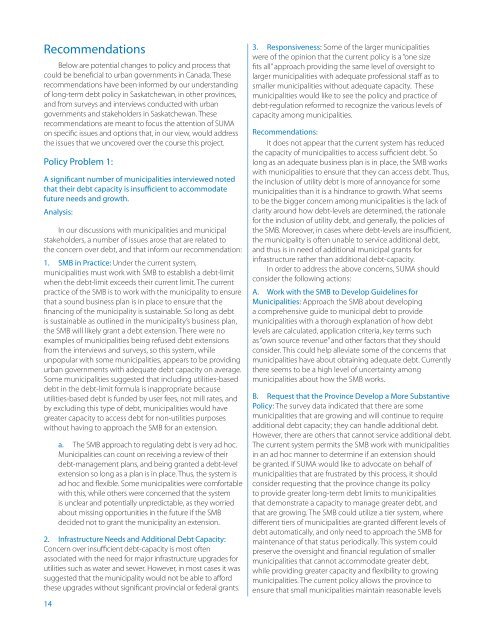Long-term Debt Limits in Saskatchewan - Nipawin
Long-term Debt Limits in Saskatchewan - Nipawin
Long-term Debt Limits in Saskatchewan - Nipawin
Create successful ePaper yourself
Turn your PDF publications into a flip-book with our unique Google optimized e-Paper software.
Recommendations<br />
Below are potential changes to policy and process that<br />
could be beneficial to urban governments <strong>in</strong> Canada. These<br />
recommendations have been <strong>in</strong>formed by our understand<strong>in</strong>g<br />
of long-<strong>term</strong> debt policy <strong>in</strong> <strong>Saskatchewan</strong>, <strong>in</strong> other prov<strong>in</strong>ces,<br />
and from surveys and <strong>in</strong>terviews conducted with urban<br />
governments and stakeholders <strong>in</strong> <strong>Saskatchewan</strong>. These<br />
recommendations are meant to focus the attention of SUMA<br />
on specific issues and options that, <strong>in</strong> our view, would address<br />
the issues that we uncovered over the course this project.<br />
Policy Problem 1:<br />
A significant number of municipalities <strong>in</strong>terviewed noted<br />
that their debt capacity is <strong>in</strong>sufficient to accommodate<br />
future needs and growth.<br />
Analysis:<br />
In our discussions with municipalities and municipal<br />
stakeholders, a number of issues arose that are related to<br />
the concern over debt, and that <strong>in</strong>form our recommendation:<br />
1. SMB <strong>in</strong> Practice: Under the current system,<br />
municipalities must work with SMB to establish a debt-limit<br />
when the debt-limit exceeds their current limit. The current<br />
practice of the SMB is to work with the municipality to ensure<br />
that a sound bus<strong>in</strong>ess plan is <strong>in</strong> place to ensure that the<br />
f<strong>in</strong>anc<strong>in</strong>g of the municipality is susta<strong>in</strong>able. So long as debt<br />
is susta<strong>in</strong>able as outl<strong>in</strong>ed <strong>in</strong> the municipality’s bus<strong>in</strong>ess plan,<br />
the SMB will likely grant a debt extension. There were no<br />
examples of municipalities be<strong>in</strong>g refused debt extensions<br />
from the <strong>in</strong>terviews and surveys, so this system, while<br />
unpopular with some municipalities, appears to be provid<strong>in</strong>g<br />
urban governments with adequate debt capacity on average.<br />
Some municipalities suggested that <strong>in</strong>clud<strong>in</strong>g utilities-based<br />
debt <strong>in</strong> the debt-limit formula is <strong>in</strong>appropriate because<br />
utilities-based debt is funded by user fees, not mill rates, and<br />
by exclud<strong>in</strong>g this type of debt, municipalities would have<br />
greater capacity to access debt for non-utilities purposes<br />
without hav<strong>in</strong>g to approach the SMB for an extension.<br />
a. The SMB approach to regulat<strong>in</strong>g debt is very ad hoc.<br />
Municipalities can count on receiv<strong>in</strong>g a review of their<br />
debt-management plans, and be<strong>in</strong>g granted a debt-level<br />
extension so long as a plan is <strong>in</strong> place. Thus, the system is<br />
ad hoc and flexible. Some municipalities were comfortable<br />
with this, while others were concerned that the system<br />
is unclear and potentially unpredictable, as they worried<br />
about miss<strong>in</strong>g opportunities <strong>in</strong> the future if the SMB<br />
decided not to grant the municipality an extension.<br />
2. Infrastructure Needs and Additional <strong>Debt</strong> Capacity:<br />
Concern over <strong>in</strong>sufficient debt-capacity is most often<br />
associated with the need for major <strong>in</strong>frastructure upgrades for<br />
utilities such as water and sewer. However, <strong>in</strong> most cases it was<br />
suggested that the municipality would not be able to afford<br />
these upgrades without significant prov<strong>in</strong>cial or federal grants.<br />
14<br />
3. Responsiveness: Some of the larger municipalities<br />
were of the op<strong>in</strong>ion that the current policy is a “one size<br />
fits all” approach provid<strong>in</strong>g the same level of oversight to<br />
larger municipalities with adequate professional staff as to<br />
smaller municipalities without adequate capacity. These<br />
municipalities would like to see the policy and practice of<br />
debt-regulation reformed to recognize the various levels of<br />
capacity among municipalities.<br />
Recommendations:<br />
It does not appear that the current system has reduced<br />
the capacity of municipalities to access sufficient debt. So<br />
long as an adequate bus<strong>in</strong>ess plan is <strong>in</strong> place, the SMB works<br />
with municipalities to ensure that they can access debt. Thus,<br />
the <strong>in</strong>clusion of utility debt is more of annoyance for some<br />
municipalities than it is a h<strong>in</strong>drance to growth. What seems<br />
to be the bigger concern among municipalities is the lack of<br />
clarity around how debt-levels are de<strong>term</strong><strong>in</strong>ed, the rationale<br />
for the <strong>in</strong>clusion of utility debt, and generally, the policies of<br />
the SMB. Moreover, <strong>in</strong> cases where debt-levels are <strong>in</strong>sufficient,<br />
the municipality is often unable to service additional debt,<br />
and thus is <strong>in</strong> need of additional municipal grants for<br />
<strong>in</strong>frastructure rather than additional debt-capacity.<br />
In order to address the above concerns, SUMA should<br />
consider the follow<strong>in</strong>g actions:<br />
A. Work with the SMB to Develop Guidel<strong>in</strong>es for<br />
Municipalities: Approach the SMB about develop<strong>in</strong>g<br />
a comprehensive guide to municipal debt to provide<br />
municipalities with a thorough explanation of how debt<br />
levels are calculated, application criteria, key <strong>term</strong>s such<br />
as “own source revenue” and other factors that they should<br />
consider. This could help alleviate some of the concerns that<br />
municipalities have about obta<strong>in</strong><strong>in</strong>g adequate debt. Currently<br />
there seems to be a high level of uncerta<strong>in</strong>ty among<br />
municipalities about how the SMB works.<br />
B. Request that the Prov<strong>in</strong>ce Develop a More Substantive<br />
Policy: The survey data <strong>in</strong>dicated that there are some<br />
municipalities that are grow<strong>in</strong>g and will cont<strong>in</strong>ue to require<br />
additional debt capacity; they can handle additional debt.<br />
However, there are others that cannot service additional debt.<br />
The current system permits the SMB work with municipalities<br />
<strong>in</strong> an ad hoc manner to de<strong>term</strong><strong>in</strong>e if an extension should<br />
be granted. If SUMA would like to advocate on behalf of<br />
municipalities that are frustrated by this process, it should<br />
consider request<strong>in</strong>g that the prov<strong>in</strong>ce change its policy<br />
to provide greater long-<strong>term</strong> debt limits to municipalities<br />
that demonstrate a capacity to manage greater debt, and<br />
that are grow<strong>in</strong>g. The SMB could utilize a tier system, where<br />
different tiers of municipalities are granted different levels of<br />
debt automatically, and only need to approach the SMB for<br />
ma<strong>in</strong>tenance of that status periodically. This system could<br />
preserve the oversight and f<strong>in</strong>ancial regulation of smaller<br />
municipalities that cannot accommodate greater debt,<br />
while provid<strong>in</strong>g greater capacity and flexibility to grow<strong>in</strong>g<br />
municipalities. The current policy allows the prov<strong>in</strong>ce to<br />
ensure that small municipalities ma<strong>in</strong>ta<strong>in</strong> reasonable levels






